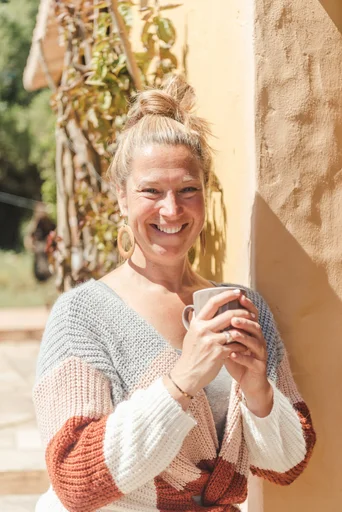Yoga for Knee Pain: 5 Poses to Add Strength & Reduce Discomfort

Why Yoga Can Help Your Knee Pain
Understanding Knee Pain
Knee pain can be caused by various factors, such as injury, overuse, or underlying conditions like arthritis. It's a common issue that affects many people, leading to discomfort and limitations in movement. Studies show that severe knee pain reduces within two weeks of practicing yoga. Specific yoga poses for osteoarthritis patients have helped reduce pain and improve mobility within two weeks of practice. A 2018 study involved 31 women with knee osteoarthritis, and those practicing yoga had more significant improvements in pain and knee function than the control group. Additionally, a 2012 study involving 250 participants with osteoarthritis found that the yoga group had less pain while walking and reduced joint tenderness.
The Magic of Yoga for Your Knees
Yoga has been proven to have a positive impact on knee function and pain. It not only makes knees stronger but also plays a crucial role in reducing discomfort. Online yoga improved physical function in people with knee osteoarthritis, as evidenced by a 12-week online yoga program that improved knee function in participants. Furthermore, appropriate yoga exercises can reduce knee pain and strengthen the muscles, making it a superb antidote to knee trouble, especially for people recovering from damaged ligaments.
1. High Lunge Pose for Knee Strength

High lunge is a powerful yoga pose that can significantly benefit your knees and contribute to their strength and flexibility.
Why High Lunge?
Benefits for your knees
The high lunge pose is particularly effective in strengthening the muscles around the knee joint. It engages the quadriceps, hamstrings, and calf muscles, promoting stability and support for the knees. Additionally, this pose helps improve flexibility in the hip flexors, which can indirectly alleviate pressure on the knees.
How it adds strength
By holding the high lunge position, you are actively engaging your leg muscles, which promotes strength and endurance. The dynamic nature of this pose also encourages balance and stability, further enhancing the overall support for your knees.
Step-by-Step Guide
Getting into the pose
Begin in a standing position at the top of your mat.
Step one foot back into a deep lunge, ensuring that your front knee is directly above your ankle.
Keep your back leg straight and strong while sinking deeper into the lunge with your front leg.
Raise your arms overhead or place them on your hips to maintain balance.
Tips for safety and comfort
Ensure that your front knee does not extend beyond your toes to prevent unnecessary strain.
Use yoga blocks under your hands if reaching the floor feels challenging to maintain proper alignment and ease any discomfort.
2. Chair Pose to Reduce Knee Discomfort
Yoga offers a powerful solution for reducing knee discomfort through the practice of the Chair Pose. This pose not only targets the strengthening of various muscle groups but also aids in alleviating knee pain and promoting overall joint health.
The Power of Chair Pose
Its impact on knee discomfort
The Chair Pose, also known as Utkatasana, is highly effective in reducing knee discomfort by engaging and strengthening the muscles surrounding the knees. This engagement helps to stabilize the knee joint and reduce strain during movement, ultimately leading to decreased discomfort and improved mobility.
Strengthening aspects
Research has shown that practicing yoga, including poses like the Chair Pose, can contribute to increased strength and flexibility in individuals with knee osteoarthritis. A 2018 study found that yoga practice had significant improvements in pain and knee function for arthritis patients, highlighting the positive impact of yoga on addressing knee discomfort.
How to Do Chair Pose
Entering the pose correctly
Begin by standing tall with your feet together.
Inhale as you raise your arms overhead, keeping them parallel to each other.
Exhale as you bend your knees and lower your hips as if you are sitting back into an imaginary chair.
Ensure that your weight is distributed evenly across both feet, with your knees aligned over your ankles.
Hold the pose for several breaths while maintaining a strong posture.
Keeping your knees happy
During the Chair Pose, focus on maintaining a steady breath and gentle engagement of the core muscles to support your lower back and knees. Avoid overarching or rounding your lower back to prevent unnecessary strain on these areas. Additionally, be mindful of any discomfort in your knees and adjust the depth of the pose accordingly to ensure a safe and comfortable experience.
Scientific Research Findings:
Limited low-quality research in knee osteoarthritis shows some benefits on pain, function, and knee stiffness from yoga programs delivered via supervised in-person group classes.
Yoga practice might mitigate injury risk by changing the athlete’s perception of their likelihood of sustaining an injury and by reducing fatigue.
Expert Opinion: Yoga is fantastic for the knees, especially for people recovering from damaged ligaments. Yoga increases the stabilizing action of the leg’s big muscles.
3. Bridge Pose for Stronger Knees

The Bridge Pose, also known as Setu Bandhasana, is a beneficial yoga posture that can contribute to strengthening the knees and reducing discomfort.
Benefits of Bridge Pose
Knee strengthening features
The Bridge Pose primarily targets the glutes (your butt muscles) and hamstrings, which play a significant role in providing stability and support to the knees. By engaging and strengthening these muscle groups, the Bridge Pose helps improve overall knee function and resilience.
Additionally, performing this pose increases stability in the core and back muscles, indirectly benefiting the knee joints by enhancing overall body alignment and support.
Alleviating discomfort
Research published in the Brazilian Journal of Physical Therapy highlighted that the bridge exercise not only strengthens specific muscle groups but also aids in alleviating discomfort by promoting better body alignment and stability. This move can also stretch muscles in your chest, abdomen, and shoulders, contributing to an overall sense of physical well-being.
Performing Bridge Pose
Step-by-step instructions
Begin by lying on your back with your knees bent and feet flat on the floor, hip-width apart.
Inhale as you lift your hips off the ground while pressing into your feet, engaging your glutes and hamstrings.
Interlace your fingers under your back and extend through your arms while rolling your shoulders underneath you.
Hold this position for several breaths, maintaining steady breathing and focusing on engaging the targeted muscle groups.
Ensuring knee safety
During the Bridge Pose, it's essential to ensure that there is no excessive strain on your knees. Focus on distributing the effort evenly across both legs to prevent unnecessary pressure on any specific joint or muscle group. Additionally, be mindful of any discomfort or pain in the knees during this pose; if you experience any discomfort, consider adjusting the height or intensity of the pose to ensure a safe practice experience.
Scientific Research Findings:
A 2018 study involved 31 women with knee osteoarthritis who practiced yoga for 12 weeks had more significant improvements in pain and knee function than those who did not practice yoga.
Yoga is fantastic for strengthening the knees, especially for people recovering from damaged ligaments.
The stabilizing action of leg muscles through yoga contributes significantly to knee health.
Practicing yoga has been associated with positive outcomes related to knee pain reduction and improved mobility in individuals with osteoarthritis.
4. Locust Pose to Support Knee Health
The Locust Pose, also known as Salabhasana, is a beneficial yoga posture that can play a significant role in supporting knee health and promoting strength and resilience in the knees.
Why Choose Locust Pose?
Its role in knee health
The Locust Pose actively engages the muscles in the legs, lower back, and core, which collectively contribute to providing stability and support to the knees. By strengthening these muscle groups, the pose helps enhance overall knee function and reduce the risk of discomfort or injury.
Strength and support for knees
Research on yoga's impact on knee health has highlighted the effectiveness of poses like the Locust Pose in improving muscle strength around the knees. This increased strength not only supports the knee joint but also aids in maintaining proper alignment and reducing strain during movement, ultimately promoting better knee health.
Mastering Locust Pose
Getting into the pose
Begin by lying on your stomach with your arms alongside your body, palms facing up.
As you inhale, lift your head, chest, arms, and legs off the mat simultaneously. Keep your gaze forward to maintain proper neck alignment.
Engage your glutes and leg muscles while lifting your legs higher to deepen the stretch.
Hold this position for several breaths while focusing on engaging the targeted muscle groups.
Tips for the best results
To maximize the benefits of this pose for your knees, focus on maintaining steady breathing throughout and avoid any excessive tension or strain in your neck or lower back.
Gradually increase the duration of holding this pose as you build strength and endurance over time.
If you experience discomfort or strain in any specific area while practicing Locust Pose, consider modifying the intensity or height of your lift to ensure a safe and comfortable experience.
Scientific Research Findings:
Yoga practice can lead to significant improvements in pain, knee function, and quality of life for individuals with knee osteoarthritis.
Many yoga poses strengthen the muscles around the knee, improve balance and alignment, and reduce knee pain.
Yoga is fantastic for the knees, especially for people recovering from damaged ligaments.
The stabilizing action of leg muscles through yoga contributes significantly to knee health.
5. Reclining Poses for Gentle Knee Relief
Gentle Relief with Reclining Poses
Reclining yoga poses provide a gentle yet effective way to alleviate knee discomfort and promote overall joint health. Two particularly beneficial reclining poses for knee relief are the Reclining Hand-to-Big-Toe Pose and the Reclining Spinal Twist Pose.
Reclining Hand-to-Big-Toe Pose
The Reclining Hand-to-Big-Toe Pose, also known as Supta Padangusthasana, offers a soothing stretch for the hamstrings and calves while promoting relaxation and ease in the knees. This pose gently engages the leg muscles, contributing to improved flexibility and reduced tension in the knees.
Reclining Spinal Twist Pose
The Reclining Spinal Twist Pose, or Supta Matsyendrasana, provides a gentle twist that helps release tension in the lower back and hips, indirectly benefiting the knees by promoting better overall alignment and reducing strain on the joint. This pose also encourages gentle stretching of the outer hip muscles, offering relief to the knees through improved flexibility and reduced tightness.
How to Practice Reclining Poses
When practicing reclining poses for knee relief, it's essential to ease into each pose gradually to allow your body to adjust and respond positively to the movements. Begin by lying on your back in a comfortable position before transitioning into each pose mindfully.
Maximizing benefits for your knees involves maintaining steady breathing throughout each pose while focusing on gentle engagement of the targeted muscle groups. By approaching these poses with mindfulness and awareness of your body's needs, you can experience enhanced relief from knee discomfort while promoting strength and flexibility in this area.
Scientific Research Findings:
Regular yoga practice may offer relief from knee osteoarthritis.
Incorporating specific yoga poses for osteoarthritis patients has helped reduce pain and improve mobility.
Limited low-quality research in knee osteoarthritis shows some benefits on pain, function, and knee stiffness from yoga programs.
Yoga is fantastic for the knees, especially for people recovering from damaged ligaments.
Reclining poses provide safe ways for working abdominal and leg muscles.
See Also
Yoga During Pregnancy: 5 Yoga Poses to Ease Lower Back Discomfort
Inquiry: What Are Some Yoga Poses for Novices?
Consultation: The Impact of Yoga on Pain Endurance | Yoga Magazine
We bring back the importance of initiation into womanhood by Roos-Veerle Krijnen & Ella-June Henrard
Welcome to the Women’s Initiation Retreat by Naked Truth Retreats, a transformative journey into the depths of your True Feminine Nature. This retreat, scheduled from 17th to 24th August 2024 in Portugal, invites you to remember the sacredness and wholeness of your being.
Roos-Veerle Krijnen & Ella-June Henrard



